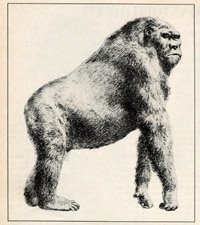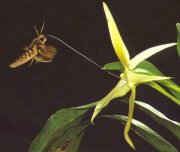Bananus humongous praedicta
The Angraecum sesquipedale Thouars orchid, native to Madagascar, is notable for having a "nectar tube of 10-12 inches in length with only the distal end filled with nectar". After studying this orchid, Charles Darwin realized there must also exist an insect equipped to fertilize it, and in 1862 Darwin wrote:
In a similar manner, after I read about a newly discovered giant ape Gigantopithecus blackii, who was 10 feet tall and weighed up to 1,200 pounds (and co-existed alongside humans!), I realized in a flash of insight that during the era of this ape-giant there must have also existed (and perhaps still does?) a kind of humongous banana, perhaps measuring as much as yard in length, for the monster to snack upon when he got hungry. I’m optimistic that sometime during the next 41 or so years someone will uncover a fossil of one of these enormous yellow fruits, as it would make perfect sense.

Giant Ape (Gigantopithecus blackii)
"It is, however, surprising that any insect should be able to reach the nectar : our English sphinxes have probosces as long as their bodies ;The moth predicted by Darwin was finally discovered 41 years later. Named Xanthopan morgani praedicta, it has a proboscis which unfurls to a length of around 10 inches.but in Madagascar there must be moths with probosces capable of extension to a length of between ten and eleven inches !" (On the Various Contrivances by which British and Foreign Orchids are Fertilised by Insects)
In a similar manner, after I read about a newly discovered giant ape Gigantopithecus blackii, who was 10 feet tall and weighed up to 1,200 pounds (and co-existed alongside humans!), I realized in a flash of insight that during the era of this ape-giant there must have also existed (and perhaps still does?) a kind of humongous banana, perhaps measuring as much as yard in length, for the monster to snack upon when he got hungry. I’m optimistic that sometime during the next 41 or so years someone will uncover a fossil of one of these enormous yellow fruits, as it would make perfect sense.



Mr. Carter, your genius knows no bounds.
ReplyDeleteMost people would say 'lunacy'.
ReplyDelete"Some believe that the primate's voracious appetite for bamboo ultimately placed him at the losing end of the evolutionary scale against his more nimble human competition."
ReplyDeleteUnlike, say, the giant Panda's voracious appetite for bamboo which ultimately placed those adorable creatures in a zoo near you.
One would think it would be an easier life if all you needed to eat was a certain kind of ubiquitous stick. I don't get.
ReplyDeleteNice photo: is that the new England prop-forward I've been reading about?
ReplyDeleteWhat's a New England prop-forward? A type of biplane?
ReplyDeleteI think the photograph of the ape was taken by the same person who took this photo of a Neanderthal:
http://www.burlingtonnews.net/bigfootorigin.html
I see speculation that the big chap lived contemporaneously with humans and then died out. I presume that, as usual, we ate him.
ReplyDelete